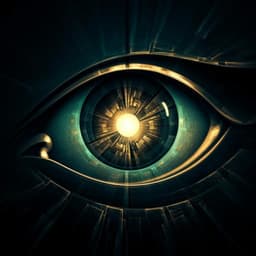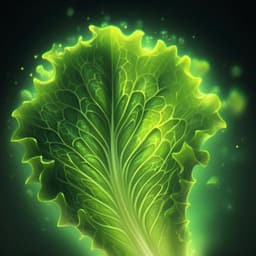
Medicine and Health
UltraSound-induced reorientation for multi-angle optical coherence tomography
M. K. Løvmo, S. Deng, et al.
Discover how ULTIMA-OCT, developed by Mia Kvåle Løvmo and colleagues, overcomes the challenges posed by optically dense specimens in optical coherence tomography. This innovative method utilizes ultrasound-induced reorientation for enhanced 3D imaging, even in the most challenging biological samples like zebrafish larvae. Dive into a new era of imaging technology!
~3 min • Beginner • English
Introduction
The study addresses the challenge of imaging optically dense and developing biological samples such as organoids, spheroids, and zebrafish embryos/larvae with OCT/OCM, where single-view acquisitions suffer from attenuation and shadow artifacts that limit penetration depth and data fidelity. Traditional immobilization in gels introduces contact, optical aberrations, and limited angular coverage; optical tweezers are unsuitable for mm-scale samples due to heating and power constraints. The authors propose ULTrasound-Induced reorientation for Multi-Angle OCT (ULTIMA-OCT), using bulk acoustic waves in a 3D-printed chamber to levitate and reorient samples non-contact for multi-angle acquisition over 360° around the major axis. They further formulate a model-based reconstruction to fuse multi-angle OCM data acquired at unknown orientations to recover reflectivity, attenuation, and refractive index maps, aiming to overcome shadowing and refraction distortions and enable volumetric imaging with enhanced penetration depth.
Literature Review
Prior work shows increasing use of organoids/spheroids for biology and oncology with efforts toward Matrigel-free culture due to variability and mechanical effects. Optical tweezers enable rotation for single cells but are unsuitable for larger aggregates due to heating and force limitations. Acoustic manipulation provides contact-free levitation and rotation: bulk acoustic waves (BAW) form standing wave nodes and can reorient objects, while surface acoustic waves (SAW) and acoustically induced microstreaming can rotate various samples (e.g., zebrafish embryos, single cells, nematodes). For imaging, BAW is favorable for tilting into stationary orientations and scaling to larger samples. OCT/OCM are label-free, high-speed volumetric modalities used widely in biomedicine, including embryos and organoids/spheroids, but suffer from shadows/limited penetration in dense specimens. Shadow-removal algorithms exist for specific ophthalmic imaging but struggle with full occlusions (e.g., pigmented zebrafish eye). Optical coherence refraction tomography (OCRT) mitigates refraction/shadowing via controlled incident angles but has limited angular range and requires immobilization in gels. These gaps motivate a non-contact, wide-angle, gel-free approach enabling multi-angle OCT acquisitions.
Methodology
System and acoustic chamber: A 3D-printed octagonal chamber (PET-G) integrates four PZT plate transducers (Pz26, 8×15×3 mm) and four opposing reflectors. The bottom is sealed with a 170 µm coverslip for optical access and acoustic reflection; the back is sealed by an aluminum plate. The chamber height is 19.2 mm, tuned via simulations/impedance characterization to support resonant BAW near 600 kHz (water wavelength ≈2.2–2.5 mm). Standing waves form with pressure nodes at λ/2 (~1 mm at ~600 kHz). Transducers are driven sinusoidally (top and S3 at 600 kHz; S1 and S2 at 590 kHz) using waveform generators and power amplifiers with impedance matching. Typical peak-to-peak voltages: 20–35 V, yielding maximum pressure amplitudes ~80–150 kPa at antinodes (hydrophone measured). The top transducer ensures levitation; side transducers modulate lateral forces/torques to reorient samples. The bottom of the top transducer electrode is blackened to reduce OCM back-reflection.
Acoustic actuation and reorientation: Samples are levitated in central nodal planes where four standing waves intersect. By tuning relative voltages (and phases) of orthogonal transducers, an acoustic restoring torque about the y-axis reorients specimens in the xz-plane. Dominant top transducer aligns the minor axis vertically (z); increasing a side transducer amplitude rotates the pressure landscape and the sample to new stable orientations. Alternating voltages across pairs enables step-wise 360° rotation about the major axis while maintaining levitation. For sufficiently asymmetric samples (e.g., zebrafish), precise angular control is achieved by exciting two orthogonal modes at the same frequency with adjustable relative amplitude and phase. The platform supports mm-scale zebrafish embryos/larvae (3–5 dpf) and sub-mm melanoma spheroids (~400 µm), with sustained rotations suppressible via phase control; stable non-rotational orientations are used for imaging.
Operation: The chamber is rinsed (0.1% Triton X-100) to reduce bubbles, filled with water/PBS, the sample inserted, and the front sealed with a coverslip (removable). Levitation is initiated with the top transducer; dark-field microscopy is used to optimize acoustic settings prior to OCM. During imaging, samples remain stably trapped without significant motion for volume acquisitions (8–23 s per angle; FOV ~0.67×0.67 to 0.76×3.78 mm). Small reversible translations/tilts can occur with reorientation, particularly along y; these are compensated in reconstruction, and FOV/z-stage are adjusted between angles as needed.
Samples: Zebrafish of wild-type Tübingen and double mutant Mitfa b692/b692 ednrb ts140/ts140 (reduced pigmentation) were fixed (4% PFA) and stored in PBS at 4 °C prior to imaging. Melanoma spheroids (murine B16-F10) were formed by hanging-drop culture (1000 cells/25 µL, 4 days), fixed in 4% PFA, washed, and stored at 4 °C.
OCM setup: Spectral-domain OCM with a compact polarization-aligned tri-SLED source (center 845 nm, bandwidth 131 nm). Axial resolution ≈3.7 µm in air (≈2.68 µm in tissue, n≈1.38); lateral ≈3.4 µm; depth of field ≈153 µm in air (≈211 µm in tissue). Objectives: 10×, NA 0.3. Sample power ≈1.53 mW. Spectrometer line rate 20 kHz; sensitivity ≈104.7 dB. Scanning step size: 1.68 µm (zebrafish head; spheroids) or 2.52 µm (whole fish). Standard OCT preprocessing (background subtraction, resampling, dispersion compensation, FFT, log scaling). En face visualizations used average intensity projection (zebrafish) or standard deviation projection (spheroids); cross-sections averaged multiple B-scans; 3D rendering via Amira 3D.
Reconstruction algorithm: Multi-angle OCM volumes (unknown relative orientations) are fused via a physics-based forward model describing line-wise OCT signal formation with reflectivity R, attenuation α, and refractive index contrast Δn. The signal model includes confocal PSF T, sensitivity roll-off H, cumulative attenuation along depth, and RI-induced pathlength updates. The inverse problem jointly estimates R, α, Δn, and motion parameters (rotation q as unit quaternions; translation t) using gradient-based optimization with data fidelity plus regularization (TV, Tikhonov), positivity, and object support constraints. A multiscale strategy first registers motion and coarse maps on downsampled data (3× smaller grids; 1000 iterations), then initializes high-resolution reconstructions (400^3–450^3 voxels; 250 iterations) for refinement. Implemented in JAX (Python 3.11) on RTX 4090; total runtime ~20 min per dataset. Regularization promotes smoothness for RI (e.g., GRIN lens) and edge-preserving constraints for reflectivity/attenuation. Datasets included 10–11 angles roughly spanning 0–360°.
Safety/compatibility: Measured pressures are below cavitation/bio-effect thresholds reported for similar acoustic platforms. Axial phase stability characterization indicates axial fluctuations within ~10 nm for acoustically trapped zebrafish, with dominant instability from the OCM system, supporting potential extensions to functional OCT modalities.
Key Findings
- The ULTIMA-OCT platform levitates and reorients biological specimens non-contact, enabling multi-angle OCM/OCT acquisitions over 360° around the major axis without mechanical rotation or scaffolds.
- Stable step-wise orientation control demonstrated for mm-scale 3 dpf zebrafish embryos/larvae (wild-type and reduced pigmentation) and sub-mm melanoma spheroids (~400 µm). Reorientation precision is tunable via transducer voltage/phase steps; sustained rotation can be avoided by phase control.
- Single-angle OCM volumes exhibit severe shadowing/attenuation artifacts (e.g., pigmented eye, yolk sac) that obscure deeper morphologies in both zebrafish and melanin-rich spheroids.
- Model-based multi-angle fusion reconstructs reflectivity R largely free of attenuation/shadow artifacts and corrects refraction-induced distortions, enhancing effective penetration depth and anatomical visibility compared to any single view.
- The algorithm jointly recovers attenuation α and RI contrast Δn; in zebrafish head, attenuation is widespread in wild-type and dominated by eyes in mutants. Reconstructed eye lens RI shows GRIN-like profiles consistent with literature values.
- Datasets: wild-type zebrafish head reconstructed from 11 angles; reduced-pigmentation mutant from 10 angles; acquisition per angle 8–23 s; FOVs ~0.67×0.67 to 0.76×3.78 mm.
- Acoustic parameters: 20–35 Vpp driving (≥20 Vpp for levitation), pressure amplitudes ~80–150 kPa; standing-wave nodes at ~λ/2 ≈1 mm (≈600 kHz).
- Motion stability: Samples remained stably trapped during acquisitions; no motion artifacts observed. Axial phase fluctuation within ~10 nm attributed mainly to OCM system, not trapping.
- Reconstruction computational performance: ~20 min total using multiscale optimization in JAX on a GPU.
Discussion
The presented approach directly addresses the limitations of single-angle OCT/OCM in optically dense specimens by providing non-contact, gel-free multi-angle data and a physics-based fusion framework that accounts for unknown orientations, attenuation, and refraction. Acoustic reorientation using BAW supports stationary orientations compatible with scanning OCT and scales to mm-sized samples far from boundaries, improving optical access and reducing aberrations compared to gel immobilization or SAW/microstreaming-based methods. The enhanced 3D reconstructions of reflectivity remove shadowing and correct distortions, effectively increasing penetration and revealing complementary anatomical features across views.
The system’s stability (no motion artifacts during 8–23 s per volume; ~10 nm axial fluctuations) suggests compatibility with advanced OCT functions (angiography, Doppler, spectroscopic, elastography) and potential multimodal integration (fluorescence, multiphoton, photoacoustic, Raman). Practical insights include controllable step-wise 360° rotation for asymmetric samples (zebrafish), manageable small translations/tilts handled by the reconstruction, and adjustable FOV/z-stage settings between angles. Compared to prior OCRT requiring gel immobilization and limited angle range, ULTIMA-OCT expands angular coverage to full 360° while maintaining high OCM resolution.
Challenges remain in acoustic parameter tuning per sample, trade-offs between wavelength/NA and penetration/resolution, and chamber design optimization. Nevertheless, the approach substantially advances volumetric imaging of dense biological models, opening avenues for quantitative analysis (e.g., internal voids/necrosis in spheroids) and longitudinal studies.
Conclusion
ULTIMA-OCT integrates acoustic levitation/reorientation with high-resolution OCM and model-based tomographic fusion to enable multi-angle, non-contact volumetric imaging of optically dense biological samples. It achieves stable 360° reorientation of zebrafish embryos and melanoma spheroids, and reconstructs reflectivity free of shadow artifacts alongside attenuation and RI maps, enhancing effective penetration beyond single-view limitations. The low-cost 3D-printed chamber is an add-on to OCT systems and broadens applicability to diverse specimens.
Future directions include: (i) adapting the platform for organoids in suspension and assessing long-term biocompatibility; (ii) simplifying chamber geometries (e.g., square cross-section, two transducers) and exploring higher-frequency operation or harmonics for smaller samples; (iii) integrating computational aberration correction or synthetic aperture methods for larger samples; (iv) expanding to functional OCT and multimodal imaging; and (v) refining the forward model and increasing angular coverage to improve attenuation and RI reconstructions.
Limitations
- Reconstruction assumptions: Attenuation modeled as angle-independent; this may not hold universally, limiting the interpretability of α. Limited number of orientations constrains the reliability of RI maps outside high-contrast regions (e.g., lenses).
- Orientation ambiguity: Unknown inter-volume orientations necessitate strong regularization and multistage optimization; while effective, this adds complexity and potential bias.
- Sample-dependent actuation: Acoustic settings require per-sample fine-tuning; reorientation can induce small translations/tilts (notably along y) and occasional drifts, albeit handled algorithmically.
- Size/shape bounds: Demonstrated for ~0.4–>1 mm thickness; exact limits for sustained vs. non-sustained rotation and trapping stiffness across geometries need further study. Prior higher-frequency platforms were limited to ~200 µm; current design likely supports >1 mm but upper bounds are untested.
- Live imaging constraints: Awake, actively swimming fish would require stronger forces with possible bio-effects; current work used fixed specimens. Long-term biocompatibility for live samples requires dedicated assessment.
- Imaging trade-offs: OCM depth-of-field and aberrations can limit uniform lateral resolution at depth; the beam underfilled the aperture to extend DOF, potentially reducing ultimate resolution.
Related Publications
Explore these studies to deepen your understanding of the subject.







